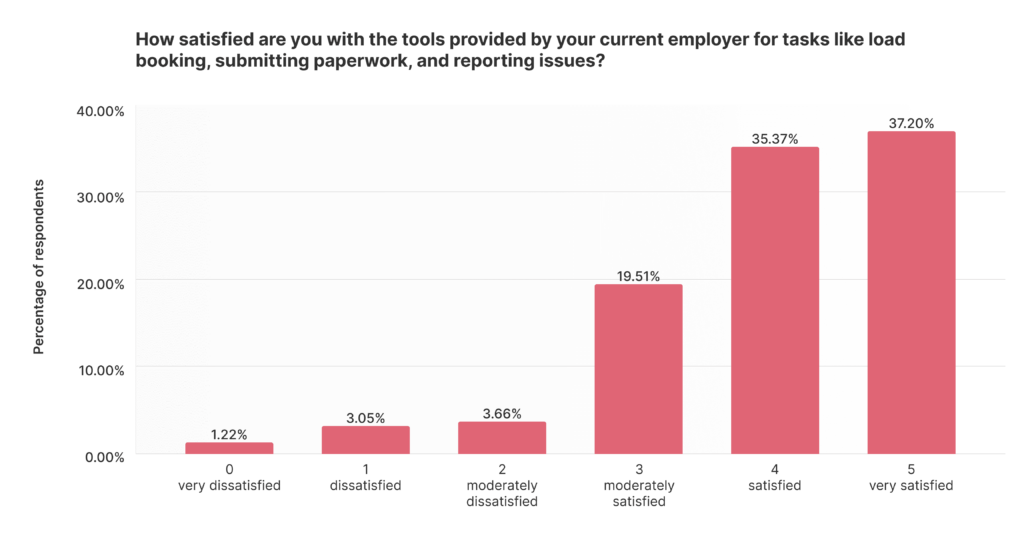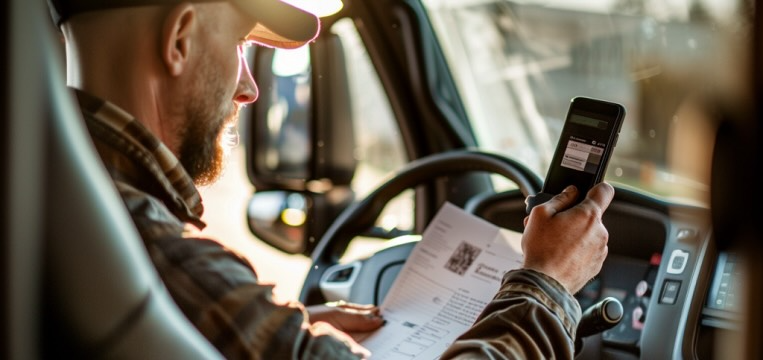The trucking industry is the backbone of the American economy. In 2022, roughly 73% of the nation’s freight weight was moved by truck. Every day, they carry the country’s most essential goods – like medicine, food, and fuel – and ensure a seamless delivery to supermarkets and households.
But truck drivers are raising the alarm over lacking support. Strikes such as that in Brazil in 2018 give a glimpse of what would happen if trucks stopped driving. Yet many companies still struggle to provide tools to meaningfully simplify their drivers’ workflows.
Even at carriers that have adopted trucking technology, drivers are expecting more. They see the need for up-to-date technology that streamlines their work. Mobile apps, in particular, are becoming increasingly important in their everyday life.
That’s why we at Scanbot SDK asked truck drivers to tell us about their experience with the tools and technologies that trucking companies provide them with. Based on their answers, we aim to offer trucking companies valuable insights into how to improve their technology to boost efficiency and driver satisfaction.
How we conducted our analysis
For our online survey, we reached out to truck drivers on Facebook and Instagram. In total, we received 164 suitable submissions. The submissions came from all over the United States and Canada, with most participants from Florida, Texas, New York, California, and New Jersey.
The participants had been driving trucks for eight years on average, and were working for over 40 companies overall. Those include large trucking firms such as J.B. Hunt, Swift, Prime, Schneider, and Old Dominion Freight Line.
Technology and features used in mobile driver apps
We asked the truck drivers what tools and app features their employers already provide them with, and how satisfied they are with them. Here is how they answered.
Technology usage during daily work
Respondents typically used several kinds of hardware and software at work. They most frequently mentioned the following:
- Mobile apps for drivers (e.g., for communication and support)
- Company-owned mobile devices (phones or tablets)
- In-cab camera systems or forward-facing dashcams
- Electronic logging devices
- GPS systems
- Fleet management software
- Other safety and compliance tools
On average, truck drivers are satisfied with their equipment, with more than 90% expressing they are at least moderately satisfied.

In particular, they appreciate the safety enhancements provided by technology, such as cameras and tracking systems, which help them feel more secure. This is an important point, considering that truck drivers spend a significant amount of their lives on the road.
They also generally appreciate tools that reduce paperwork and provide real-time updates, making tasks more manageable and efficient. Overall, drivers are happy with the technology they use to work, stating that it meets or exceeds their needs and contributes to a better work experience.
Drivers’ concerns with trucking technology
However, a number of drivers considered the technology provided outdated and insufficient. They expressed a need for more modern tools and frequent updates to meet industry standards. Some even report grave technical problems, such as devices malfunctioning, being too slow, or functionality being limited in areas with network connection issues. These problems reduce their work efficiency and lead to frustration.
Other drivers are indifferent or have mixed feelings about the technology. While not entirely dissatisfied, they see potential for improvement, pointing out that the technology would often work better with updates and enhancements.
This has consequences for job satisfaction: An overwhelming 87.20% of drivers say they would prefer an employer that invests in new technology for its fleet and drivers. Even drivers who are on the whole satisfied do nevertheless prefer up-to-date technology.
Mobile app usage and common issues
Today, most employers equip their drivers with mobile apps: 75% of respondents say that they use a mobile driver app in their daily work.
Overall, these drivers are satisfied with these apps, with over 90% of them at least moderately satisfied.

The high satisfaction results are driven by features that make the app’s user experience smooth and helpful, such as:
- GPS and navigation: Real-time traffic updates, distance logs, and navigation aids are highly valued for providing accurate directions, tracking, and route optimization. However, frequent updates are crucial to maintain usefulness.
- Communication and connectivity: Features that enable connecting with colleagues and supervisors improve coordination and support.
- Tracking and logging: Automatic schedule and task tracking helps drivers collect and send data to employers with minimal effort, reducing administrative overhead. GPS logging and tracking for tax purposes are also valued.
- Safety and management: Notifications and alerts about directions and delivery times contribute to safer and more efficient driving.
- Additional features: Document signing and management, artificial intelligence, route suggestions, checking load information, maintenance updates, as well as integrated apps like different Google apps were also mentioned as beneficial.
However, frustration emerges when the technology doesn’t work as it should. Truck drivers report apps freezing, loading slowly, lagging, and crashing or glitching.
A major culprit is the lack of internet access in remote areas. This causes network connectivity issues, keeping truckers from using their driver apps. Apps have to work offline and be reliably accessible even without a connection for them to work at crucial times.
There are a number of other common issues. Some apps are incompatible with other necessary apps or drain the device’s battery too quickly. Often, missing updates are at the root of the problem. Other apps are updated regularly, but reset pre-filled data on their own, causing even more work for the drivers. Even though truck drivers strongly rely on them, faulty GPS systems might provide inaccurate directions.
Electronic log books, which are supposed to streamline workflows, become meaningless if drivers see them as cumbersome. The lack of reliability and speed causes disruptions in otherwise smoothly running workflows.
Drivers also complain about frequent password changes and 2-factor authentication login, which they see as annoying and time-consuming. Too much or too little: Excessive and poorly managed notifications and tracking are both seen as disruptive.
What truck drivers expect
Our results make one thing clear: We have to see truck drivers as the experts they are when it comes to their jobs and start listening to what they actually need.
When we asked them what features they would expect from a mobile driver app, this is what they answered.
- Recommendations: Getting recommendations is the most sought-after feature, ranging from recommendations for fuel stops over rest areas to truck scales. Truck drivers need tools that assist them outside of their driving hours, besides tools that facilitate their work in the cabin.
- Live updates: The second-most mentioned feature truck drivers expect is real-time updates on weather and road conditions.
- Tracking: Truckers expect a driver app to reliably track breaks, drop-off points, or other stops on the route – all points they have to be able to prove.
- Navigation: Built-in navigation in a driver app is crucial since choosing the best route at any given moment is essential for drivers. Built-in truck systems may be limited or not up-to-date.
- Document scanning: Several drivers expressed a need for accurate scanning of documents, such as BoLs, fuel receipts, and others. Having to send these documents separately and in bad quality instead of simply scanning them using the app means wasted time.
- Communication: Drivers want integrated messaging features to communicate directly with headquarters, customers, or other drivers. Staying informed about load schedules, route changes, and pick-up/drop-off protocols is essential for smooth operations for truck drivers. Delayed or damaged cargo, for example, has to be communicated promptly so that problems can be solved as soon as possible.
- Safety and maintenance: Apps may also contribute to road safety. Drivers can benefit from learning about safety practices and emergency behavior with integrated safety training. Regular vehicle inspections are crucial for safe driving, so a truck driver app should have a built-in feature to log vehicle inspection reports and track repair and maintenance works. Truck drivers are also highly interested in added emergency technology.
What trucking companies can take away from our survey
“TRUCKERS NEED ANY HELP THEY CAN GET TO MAKE THINGS EASIER”
Investment in modern technology
An impressive 87.20% of the 164 truck drivers who participated in our survey stated that they would prefer to work for an employer that invests in new technologies for its fleet and drivers. This highlights the need to provide drivers with up-to-date and efficient tools. As the trucking industry evolves, so do drivers’ demands, and truck drivers are telling us that not enough has been done so far.
“I hope more incentives are released for companies to provide more technology. I’m doing just fine myself, but other drivers do desperately need some.”
The truck drivers we surveyed were clearly of the opinion that companies needed to provide more and invest in better technology. Enhanced safety features, such as in-cab camera systems, are especially sought after.
We also found that investing in a modern driver app including GPS, communications, and document management features would not only provide truck drivers with a better working experience – they would also result in more efficient workflows, reducing costs.
Essential features in a user-friendly mobile driver app
Several truck drivers’ preferred features can be combined in a single truck driver app, making them a cost-effective way of delivering modern trucking technology. Enhancing mobile driver apps – or developing them – should therefore be a priority.
While doing so, trucking companies should focus on the following aspects to meet all the requirements necessary for a reliable modern driver app.
User-centric design
Truck driver apps need to be easy to use, reliable, and fast. Anything else defeats their purpose.
And yet, truck drivers report that their apps are difficult to navigate because of chaotic UI design or broken search systems. Some driver apps are incompatible with other necessary apps. Still others bother drivers with frequent password changes and poorly managed notifications. This can prevent truck drivers from using apps as often as needed.
“The application should be easy to use and shouldn’t have really complex menus and the responses should be fast.”
Essential features
According to the truck drivers who answered our survey, a modern and effective mobile truck driver app should have the following key capabilities to meet their needs:
- Real-time updates on weather and road conditions
- Integrated navigation and route optimization
- Document scanning and management
- Reliable communication and connectivity tools
- Safety and compliance features
- Point-of-interest recommendations
Regular updates and technical support
Our respondents were eager to point out that missing updates, outdated technology and slow support are the reasons for many of their frustrations. Continuously updating mobile driver apps and providing reliable technical support streamlines workflows and ensures that issues are addressed promptly.
One best practice is to introduce a feedback system. When drivers can easily provide feedback on tools and apps, this helps ensure that their actual needs are addressed and apps are continuously improved.
Encouraging technology adoption
“If it comes from an average tech company, the user’s privacy won’t be respected. Some people won’t want to download it, and people will be forced to choose between allowing un-private apps or not working in trucking.”
Several drivers expressed hesitation about using their mobile driver apps due to concerns about tracking. Drivers are especially concerned about privacy violations when asked to use a mobile driver app on their own mobile devices.
One way around to address this concern is to provide dedicated devices for work tasks, as well as creating incentives for drivers to use and adopt the new technology. This would help ensure privacy and result in more efficient workflows at the same time.
Conclusion
Asking truck drivers about the tools they work with daily gave us valuable insight into their wants and needs. Mobile truck driver apps already play an essential part in their work, combining several valuable features they need day to day.
However, trucking companies have to start investing in the reliability of the technology if they want to profit from it. From our survey, we learned that far too often, truck driver apps and other tools don’t work well enough and become more of a disruption than actually streamlining processes.







